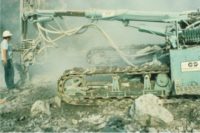By Jacek Mazurek, MD, MS, PhD and David Weissman, MD
Silicosis is a potentially fatal but preventable occupational lung disease caused by inhaling respirable particles containing crystalline silicon dioxide (silica). Quartz, a type of crystalline silica, is the second most abundant mineral in the earth’s crust and workers across a wide range of occupations and industries are exposed to silica-containing dusts. The risks, causes, and prevention of this avoidable disease have been known for decades. There is no cure for silicosis and only symptomatic treatment is available, including lung transplantation for the most severe cases. New national data have become available since a prior report on silicosis surveillance was published earlier this year. The new data show that silicosis continues to cause or contribute to the deaths of about 100 Americans each year. There were 88, 103, and 111 such deaths in 2011, 2012, and 2013 respectively.
The most common form of silicosis, chronic silicosis, takes at least 10 years from first exposure to develop and death does not typically occur until many years after that. Onset of silicosis can be faster and the severity of disease worse in the setting of high level exposures, which can cause accelerated or acute silicosis. From 2011-2013, 12 people younger than 45 years of age had silicosis listed as causing or contributing to death. Although we do not know the details of their cases, this is concerning because silicosis deaths in these young adults may reflect higher exposures than those causing chronic silicosis mortality in older individuals.
Examples of occupations with known high silica exposure include…Click here to read the rest of the blog post.


